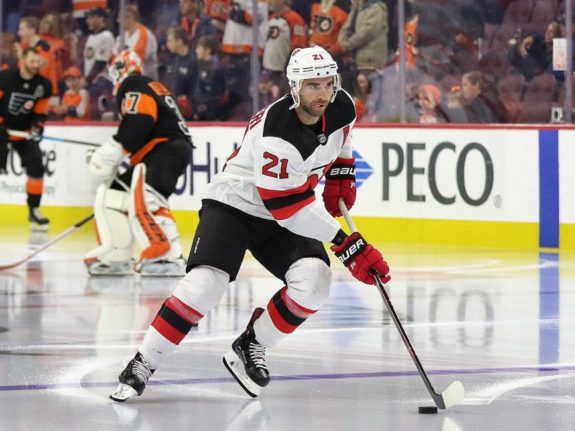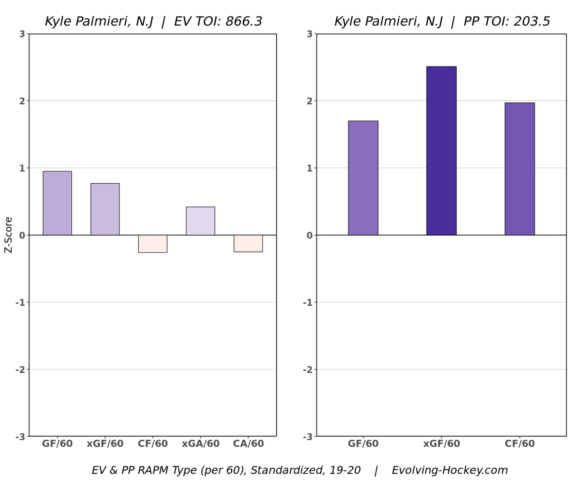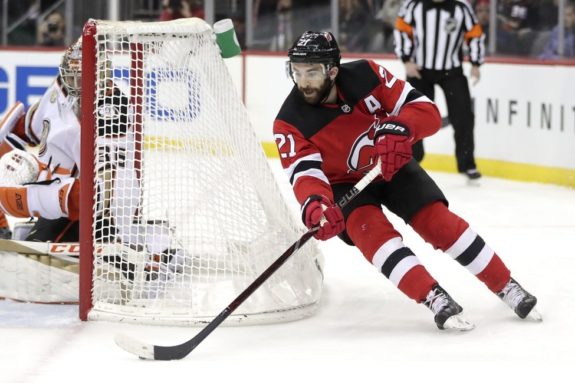There weren’t a lot of constants for the New Jersey Devils this season. From the firing of head coach John Hynes, as well as general manager Ray Shero, there was plenty of turmoil to go around. But if there was one person who could be counted on, it was Kyle Palmieri, who had 25 goals and 45 points in 65 games at the time of the NHL suspension.
Palmieri was the subject of plenty of rumors around this season’s trade deadline. But the Devils hung on to him, and that was the right move for a couple of reasons. One being he’s the team’s best winger. The second being they also need veterans to help build around young, core pieces like Jack Hughes and Nico Hischier. Here’s a look back on Palmieri’s season and what lies ahead.
The Devils’ Goal-Scoring Machine
When the Devils acquired Palmieri from the Anaheim Ducks in 2015, he had yet to turn into the player he is. But it didn’t take long for him to become one of their best goal scorers, as he totaled 30 in 2015-16, his first season in New Jersey. In the following three seasons, he finished with no less than 24 goals and averaged 29.2 goals per 82 games. His 2019-20 goal rate was right around that mark, as he was on pace to finish with 30.

The Devils don’t drive possession when Palmieri is on the ice, but their results were still positive — they had a 51.76 expected goals share (xGF%). That ranked third on the team to Joey Anderson and Dakota Mermis, the latter of whom only played in 10 NHL games. A big reason for that xG share is because of Palmieri’s underrated defensive game, as the Devils only gave up 2.22 xG against with him on the ice.
On the offensive end, it was business as usual for Palmieri. He was the Devils’ fifth-most efficient scorer at five-on-five, averaging 1.80 points per 60 minutes (points/60), which was a bit above the 1.60 points/60 he averaged over the previous three seasons. His scoring rates on the power play were also among the team’s best, as he ranked third in scoring efficiency. Overall, Palmieri had a generally positive offensive impact at even strength. But where he shined was on the power play, as he had a significant positive impact generating xG, shot attempts (CF/60), and goals for per 60 minutes.

When you think of elite NHL shooters, Alex Ovechkin, Auston Matthews, and Patrik Laine probably come to mind. But Palmieri is right there with them, and it’s why he’s such an offensive threat. For the 2019-20 season, his predicted shooting talent was 21.8% above average (via Money Puck). For comparison’s sake, Ovechkin’s predicted shooting talent was 22.3% above average, while Matthews’ was 24.9% above average, and Laine was 28.9% above average. It’s hard to find shooting talent like that, so it’s easy to see why interim GM Tom Fitzgerald hung on to Palmieri at the trade deadline.
What’s Next for Palmieri
It’s clear Palmieri is the best goal scorer on the team, so there’s no doubt he’ll be in a top-six role in 2020-21. He’s played well with Hischier on the top line for three seasons now, and I’d expect that to continue moving forward. But unlike the previous seasons, they’ll need a new left-winger after the Devils traded Taylor Hall to the Arizona Coyotes.
Related: Revisiting the Devils’ Trade for Alexander Mogilny
There are a couple of candidates who can play with Hischier and Palmieri, one being Jesper Bratt. The three of them played over 120 minutes together after Hall’s trade and had plenty of success — the Devils had an xGF% over 59% with them on the ice. Bratt was also arguably the team’s best player down the stretch, and it looks like he’s ready for a permanent top-six role.
Another option would be giving Nikita Gusev a shot with Hischier and Palmieri. The Devils moved Gusev to right-wing after he struggled in making the transition from the KHL to the NHL this season. But he’s played left-wing his whole career, so moving back to the opposite side shouldn’t hinder him much. He was the Devils’ most efficient five-on-five scorer in 2019-20, and his pass-first mentality would be a great fit alongside a shooter like Palmieri.

Palmieri could also be staring down the barrel of some history in 2020-21. With 132 career goals as a Devil, he needs just 20 more to become one of their top 10 goal scorers. He’s averaged 29.8 goals per 82 games as a Devil, so he should have no problem reaching it, assuming he plays in a majority of their games.
That’s what may be next for Palmieri on the ice. But he’s also eligible to receive a contract extension on July 1 — he has one year left on his deal that pays him $4.65 million. Given his production with the team, it’s safe to say he’s due for a big pay raise.
Related: Devils’ Top 10 Goal Scorers of All Time
The Devils likely want to get him signed long-term, even if they move on from Fitzgerald, and they shouldn’t hesitate to do so. He’ll likely command 5-plus years and somewhere around $6-7 million annually. Cap space is not a problem for the Devils, and replacing a shooting talent such as him is easier said than done. So it wouldn’t be a surprise to see the two sides agree on a new deal this summer.
Palmieri Will Help Lead a Devils’ Resurgence
All in all, Palmieri was one of the Devils’ best players in 2019-20, if not the best one. He’ll have a significant role next season, and he’s probably a strong candidate to become the team’s next captain after they traded Andy Greene in February. If the team is to become playoff contenders, there’s no doubt Palmieri will be one of the players leading the way.
* * *
Advanced stats from Natural Stat Trick, RAPM chart from Evolving Hockey